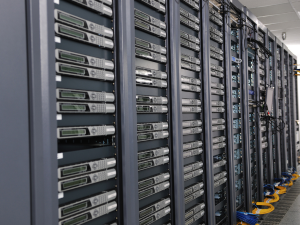
TLDR: IT energy costs rise when outdated equipment, idle servers, and inefficient cooling waste power. Businesses can lower expenses by upgrading to energy-efficient hardware, scheduling idle systems, optimizing server loads, and shifting workloads to the cloud with providers like Microsoft Azure or Google Cloud. Smarter habits, modern networks, and hardware consolidation improve performance while reducing power use. Inland Productivity Solutions helps companies design and maintain energy-efficient IT systems that cut costs, increase uptime, and support long-term sustainability.
Ever feel like your IT bill keeps rising even though your operations haven’t changed? Computers stay on overnight, servers hum endlessly, and cooling systems run full tilt all day. Most businesses don’t realize how much of their IT cost comes from wasted energy, not growth. The fix isn’t cutting corners—it’s working smarter.
Energy-efficient IT isn’t about reducing performance. It’s about using resources more intelligently. With a few focused steps, you can reduce IT energy costs, maintain reliability, and even extend your hardware’s life span.
Why IT Energy Costs Add Up
Energy waste in IT is often invisible but constant. Common culprits include:
- Servers running 24/7 even when idle.
- Outdated hardware that uses twice the power of newer models.
- Poor cooling setups where overworked air conditioning fights unnecessary heat.
- Oversized systems running minimal workloads.
A single underutilized server can burn hundreds of dollars in wasted power each year. Multiply that by your entire setup, and you’ll see why small inefficiencies add up fast.
Quick Wins for Lower Energy Use
Energy savings don’t have to wait for a major upgrade. Here are easy wins that work right away.
1. Turn Off or Schedule Idle Systems
If desktops, servers, or test environments sit idle overnight, they’re burning money. Use power-scheduling tools to shut them down automatically. Set nonessential systems to sleep mode after hours, weekends, or holidays.
2. Use Smart Power Management
Modern operating systems include built-in settings that adjust power based on usage. Enable “balanced” or “eco” power profiles in Windows or BIOS settings. These reduce energy draw without slowing performance.
3. Upgrade to Energy-Efficient Hardware
Replacing outdated desktops and monitors can cut energy use in half. LED displays use 40% less power than old LCDs. Laptops and mini-PCs handle office workloads easily while drawing a fraction of the power of full towers.
4. Rethink Workstations
Not every role needs a high-end machine. Standard users who handle documents, calls, or email can use efficient laptops instead of desktops. Reserve heavy-duty hardware for those who truly need it.
These changes are simple, affordable, and deliver fast results—often visible within the first billing cycle.
Cloud Efficiency: Using Resources Smarter
Cloud computing is one of the best ways to modernize while improving IT energy efficiency. Rather than maintaining power-hungry on-premise servers, businesses can shift workloads to shared cloud environments that are far more efficient.
- Virtualization & Elasticity: Cloud servers scale up and down with your workload, so you only use (and pay for) what you need.
- Modern Data Centers: Providers like Microsoft Azure and Google Cloud operate at massive scale, optimizing cooling, hardware use, and renewable energy sourcing.
- Reduced Idle Power Draw: With fewer on-site machines running 24/7, your office’s baseline energy use drops dramatically.
Hybrid models work well for small and mid-sized businesses. Keep local servers for critical operations, and move backups, file sharing, or analytics to the cloud. You’ll save power without losing control.
Optimize Network and Server Infrastructure
Once the basics are handled, it’s time to refine the backbone of your network.
1. Replace Old Networking Gear
Switches, routers, and storage units more than five years old are energy hogs. Newer equipment uses less power per gigabit while offering faster throughput and better reliability.
2. Consolidate Workloads
Running several half-empty servers wastes energy. Combine workloads using virtualization tools so each machine operates near optimal load. You’ll need fewer servers and less cooling.
3. Monitor Power Draw
Use energy-monitoring software to track utilization and temperature. Identify systems that run hot or idle too often, then make adjustments. Visibility turns guesswork into control.
4. Improve Cooling and Layout
Even cable management and airflow affect efficiency. Keep vents clear, raise servers off the floor, and maintain consistent room temperatures. Every degree cooler you can achieve through smart airflow means less work for air conditioning.
Small optimizations across your network add up to noticeable savings—without ever touching performance.
Employee Habits That Make a Difference
Even the best equipment can’t save energy if people use it carelessly. Encourage small habits that collectively make a big difference:
- Turn off monitors when stepping away for long periods.
- Shut down systems instead of leaving them in standby overnight.
- Unplug chargers and peripherals when not in use.
- Limit unnecessary printing—digital documents save both paper and power.
- Display friendly reminders in break rooms or on log-in screens about saving energy.
These actions are free and help build a culture of IT sustainability for business that everyone participates in.
Long-Term ROI: Saving Money and the Planet
Energy-efficient IT is one of those rare things that helps your budget and the environment at the same time. It’s also a smart move for your business reputation.
- Lower Operating Costs: Reducing wasted power and cooling saves real money month after month.
- Better Performance: Optimized systems actually run faster and more reliably because they’re not overloaded or overheating.
- Sustainability Goals: Clients, partners, and employees notice when a company takes sustainability seriously.
- Hardware Longevity: Cooler, well-managed equipment lasts longer, reducing replacement costs.
- Preparedness for Growth: As energy prices rise, efficient systems keep you insulated from unexpected cost spikes.
By treating efficiency as part of your strategy—not just a budget line—you create long-term stability and a cleaner footprint.
Power Up Your Business
If your business is ready to cut energy costs without losing performance, Inland Productivity Solutions can help.
Let’s make your IT setup leaner, greener, and stronger—because saving energy should also mean powering up your business.
FAQ
How much can businesses save with energy-efficient IT?
Typical savings range from 10% to 30%, depending on your current setup. Businesses with older equipment or inefficient scheduling often see the biggest gains.
Does cloud migration really reduce energy costs?
Yes. Cloud providers use advanced cooling, efficient hardware, and renewable energy. You also avoid powering idle on-site servers, reducing both electricity and maintenance costs.
What are some affordable upgrades to start with?
Switch to LED monitors, replace outdated routers, and move file storage to the cloud. These changes require little investment and deliver quick results.
Can Inland help us implement these changes?
Absolutely. We analyze your infrastructure, recommend practical upgrades, and handle everything from migration to monitoring so your team can focus on daily work.



